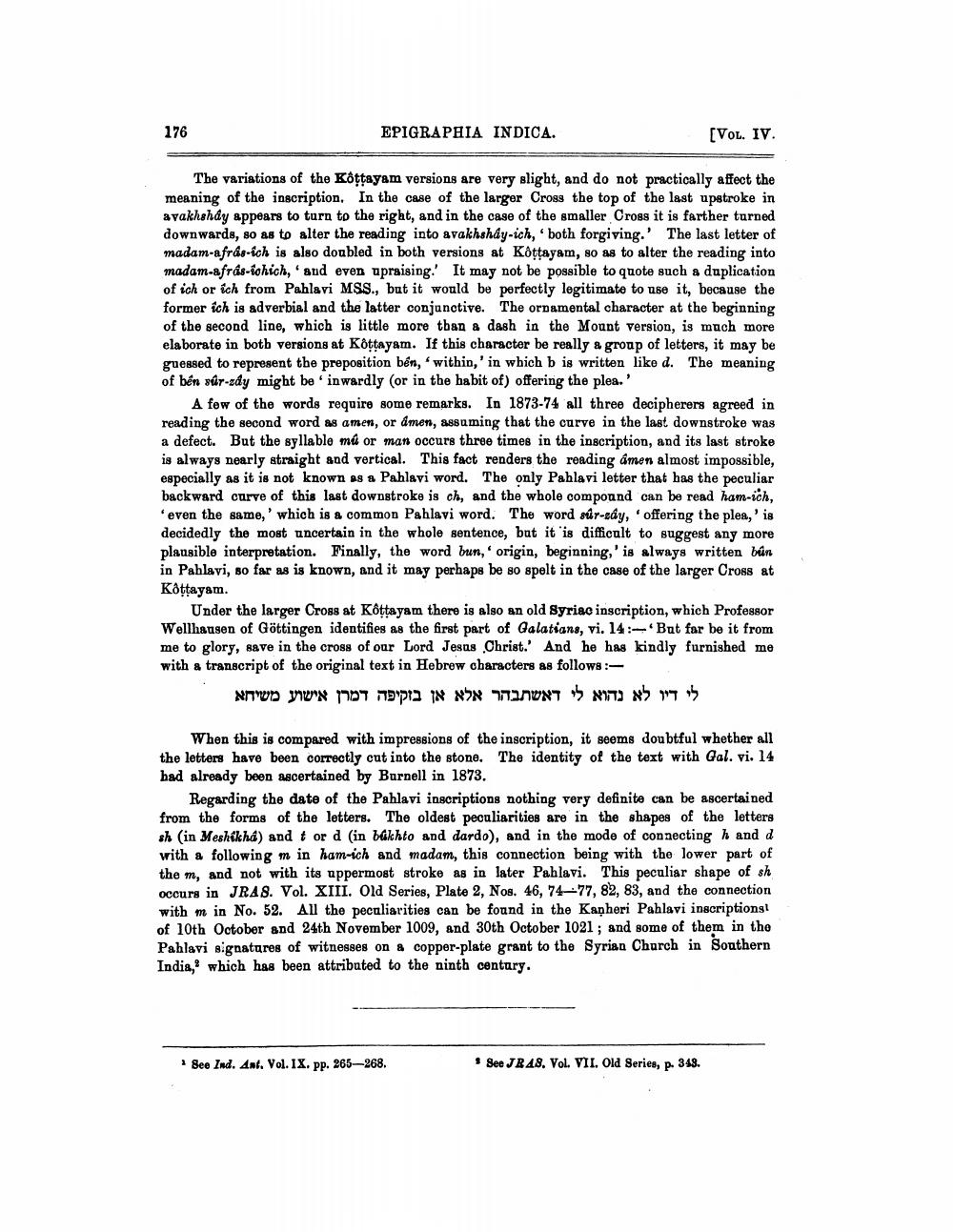________________
176
EPIGRAPHIA INDICA.
[VOL. IV.
The variations of the Kottayam versions are very slight, and do not practically affect the meaning of the inscription. In the case of the larger Cross the top of the last upstroke in avakhsháy appears to turn to the right, and in the case of the smaller Cross it is farther turned downwards, so as to alter the reading into avakhsháy-ich, both forgiving.' The last letter of madam-afrás-ich is also doubled in both versions at Kottayam, so as to alter the reading into madam-afrás-ichich, and even apraising.' It may not be possible to quote such a duplication of ich or ich from Pahlavi MSS., but it would be perfectly legitimate to use it, because the former ich is adverbial and the latter conjunctive. The ornamental character at the beginning of the second line, which is little more than a dash in the Mount version, is much more elaborate in both versions at Kottayam. If this character be really a group of letters, it may be guessed to represent the preposition bén, 'within,' in which b is written like d. The meaning of bên sør-sdy might be inwardly (or in the habit of) offering the plea.'
A few of the words require some remarks. In 1873-74 all three decipherers agreed in reading the second word as amen, or amen, assuming that the curve in the last downstroke was a defect. But the syllable mů or man occurs three times in the inscription, and its last stroke is always nearly straight and vertical. This fact renders the reading amen almost impossible, especially as it is not known as a Pahlavi word. The only Pahlavi letter that has the peculiar backward curve of this last downstroke is ch, and the whole compound can be read ham-ich,
even the same, which is a common Pahlavi word. The word sür-edy, offering the plea,' is decidedly the most uncertain in the whole sentence, but it is difficult to suggest any more plausible interpretation. Finally, the word bun,' origin, beginning,' is always written bún in Pahlavi, so far as is known, and it may perhaps be so spelt in the case of the larger Cross at Kottayam.
Under the larger Cross at Kottayam there is also an old Syriac inscription, which Professor Wellhaugen of Göttingen identifies as the first part of Galatians, vi. 14:- But far be it from me to glory, save in the cross of our Lord Jesus Christ.' And he has kindly furnished me with a transcript of the original text in Hebrew characters as follows:
לי דיו לא נהוא לי דאשתבהר אלא אן בזקיפה דמרן אישוע משיחא
When this is compared with impressions of the inscription, it seems doubtful whether all the letters have been correctly cut into the stone. The identity of the text with Gal. vi. 14 had already been ascertained by Barnell in 1873.
Regarding the date of the Pahlavi inscriptions nothing very definite can be ascertained from the forms of the letters. The oldest peculiarities are in the shapes of the letters sh (in Meshikha) and t or d (in bakhto and dardo), and in the mode of connecting h and d with a following m in ham-ich and madam, this connection being with the lower part of the m, and not with its uppermost stroke as in later Pahlavi. This peculiar shape of sh occurs in JRAS. Vol. XIII. Old Series, Plate 2, Nos. 46, 74-77, 82, 83, and the connection with m in No. 52. All the peculiarities can be found in the Kapheri Pahlavi inscriptions! of 10th October and 24th November 1009, and 30th October 1021; and some of them in tho Pahlavi signatures of witnesses on a copper-plate grant to the Syrian Church in Southern India,' which has been attributed to the ninth century.
* See Ind. Ant. Vol. IX. Pp. 265–268.
See JR 48. Vol. VII. Old Series, p. 348.




